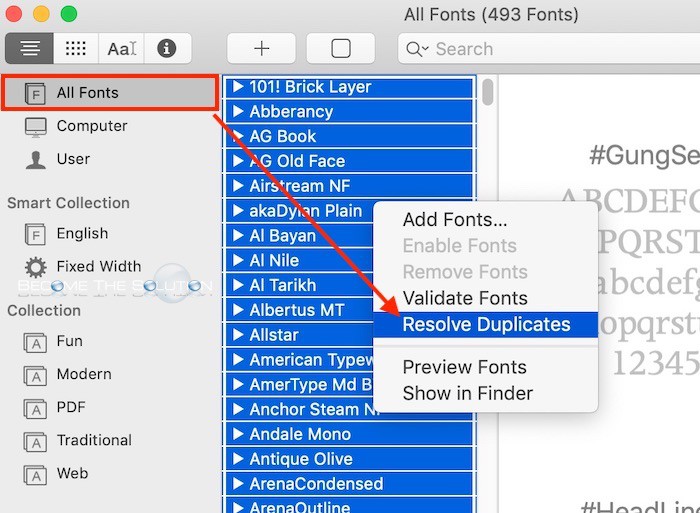

To serif or not to serif?Īlthough you may not know the serif by name, you’ll definitely have noticed these little lines or strokes coming off the end of letters in certain fonts like Times New Roman (and the modified Times font that we use here on the Reedsy blog!). Though you obviously want your font to look nice on the page, it also needs to do its job and be easily readable so that readers can immerse themselves in your words without getting distracted or having to decipher what things say. It may be the most gorgeous thing to look at, but if it’s uncomfortable to sit on, then what use is it really? The same goes for fonts. Having said that, there are a few things that any discerning book designer will want to keep in mind. With the exception of a few universally reviled typefaces - cough cough, Comic Sans - almost any legible font can be considered.
FONTBOOK AND RIGHTFONT HOW TO
How to choose a book fontĬhoosing the 'right' font to use for a book's body matter often comes down to individual taste. However, for convenience’s sake, we’re going to be using the term ‘font’ to refer to both the overall styles of type and their variations. ‘Fonts’, on the other hand, are size, weight and style variations on typefaces, like 12 pt Times New Roman bold and 14 pt Arial italic. True typography experts will be quick to point out how the term ‘font’ is commonly misused in everyday, non-technical conversation.įor typographers, ‘typefaces’ are different lettering designs, like Times New Roman and Arial.
FONTBOOK AND RIGHTFONT PDF
If you want a document that you can open on any computer at all, and you don’t need to worry about whether that computer has the font or not, save your document as a PDF file.Before we get started, let’s clear up a terminological detail.
:max_bytes(150000):strip_icc()/001-how-to-manage-mac-fonts-with-font-book-2260816-e81d66286e624d3b9a2f3bcfef36ff97.jpg)
Most of the time the fonts will just work and you won’t need to worry about them, but every now and then you might go to open one of your documents on a different computer and the font will be missing. For example in the following example the Arial font has quite a few files, one for the bold one for the italic and so on. If you are copying a font be sure to copy all the different font files.
FONTBOOK AND RIGHTFONT INSTALL
There will be either a button saying ‘ install’ which will install the front onto that computer if you click on it, or there will be a little grey message saying ‘ installed’ which means that that font is already installed on that computer. On the new computer you simply need to double-click the font and you will get a little window showing you a preview of what the font looks like. You can drag the font to a thumbdrive, e-mail it to yourself at a different computer, or copy it across the network to your laptop. If you want to copy one of these fonts to a different computer you can just copy it like any other file. The second one in your user directory contains just the fonts that are available to your user. The first fonts folder contains the fonts available to any user on your computer. Inside both of these ‘Library’ folders will be another folder called fonts, and inside the font folder will be all the fonts on your computer. You find it by clicking on your hard drive icon, then ‘Users’ then your username, and then you should see it in amongst your music, movies folders and so on. The other one is here in your ‘users’ folder: It may also be that you have deliberately purchased one or more new fonts and added them to your computer.Īll these fonts are stored in a ‘font’ folder inside your ‘library’ folder. Lots of software, for example Comic Life, iWork and Microsoft Office, install extra fonts onto your computer when they are installed. If you have installed a new printer for example from Canon or Epson, it may have come with extra fonts that were installed on your computer. This article looks at where the fonts live on your computer and how you can you copy them to another computer.Ĭhances are you have more than the fonts that just came with your computer. This can cause a problem if you create a keynote presentation or pages document on your computer, and then you go to use it on a different laptop where those fonts are not installed. OS X comes with a heap of built-in fonts (eg Helvetica, Arial, Lucida Grande) but chances are you have more than just these few on your computer. A font is what your computer uses to display and print text.


 0 kommentar(er)
0 kommentar(er)
